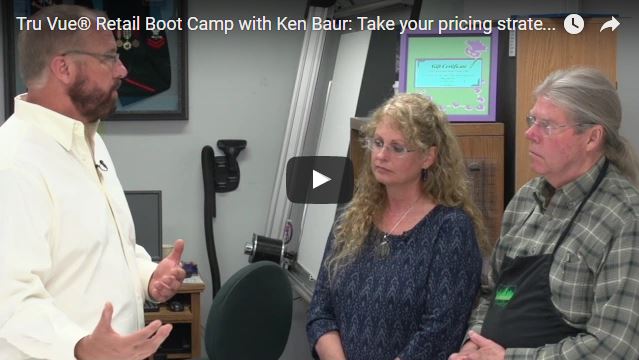The second Tru Vue Retail Boot Camp provided a business consultation from Ken Baur, president of KB Consulting. This article covers how winners Larry and Rene Bauer of Karon’s Frame Center in Port Angeles, WA, successfully worked with Ken to take their pricing strategy to the next level.
Main challenge in pricing
One of the biggest challenges facing custom frame shop owners is determining their pricing strategy. You want to strike the right balance with pricing so that you don’t discourage customers, but are also able to cover your operational expenses, material costs, and allow for remaining profit.
In the case of Karon’s Frame Center, the stores pricing strategy was quite close to where it needed to be. The Bauers were doing many things correctly, limiting discounting, covering expenses, and making an 18-percent gross profit (here is an overview of definitions financial terms).
If you recall from the last post, this is unusual in an industry when the average rate of discounting is 18 percent (you can read about this statistic in this post). What the Bauers were doing was based on instinct and confidence in their pricing. They understood the value of what they were offering customers and had a good sense of what they needed to run their business. Yet, no matter how good your intuition is, it is always wise to get a solid grasp of your business financials through proper analysis.
Initial analysis found $10,000
After analyzing their financials, though, we saw that there was room to push the pricing even more. Adjusting the margins on frames ($6), matting ($9) and glazing ($2) would keep their prices reasonable for customers but resulted in an average ticket increase of $17. This slight increase can generate nearly $10,000 in cash flow over the course of a year if sales and discounts remain at current levels. Remember, that that pricing at Karon’s Frame Center was very close to maximized before we began the Retail Boot Camp, imagine a business with potential for greater increases what a through analysis and correct pricing strategy would do to profits.
In a business analysis, I look at a number of factors, but the one I think is the best way to determine if a shop needs to change its pricing is cash flow. The bank account should be growing if a business is sticking to a well-planned budget. The goal is a minimum of 10 percent of sales left over after paying expenses for a 12-month period.
Take you pricing to the edge
If there is room in your pricing for increases, even small increases, as in the case of Karon’s Frame Center, you can take your pricing to the edge without having a negative impact on your business. If you are feeling that edge, you know you are doing the right thing by pushing your pricing there. Most projects should feel natural, but in those cases where projects seem over-priced, you may need to make some minor adjustments to the tables. Shortly we will cover this topic in a posts series that will outline in more detail how to re-work your tables, so that premium materials receive special pricing attention so that they are attractive to customers, yet still, produce correct profit returns.
One thing I hear from business owners about increasing pricing is the fear of price objections. Rarely is this ever the reality. Most of the time, if we’ve done a thorough analysis of your shop’s financial performance and come up with a pricing strategy, you will experience increased business.
With their modest increases and feeling that they had taken the pricing to the edge, Larry and Rene saw success with their new pricing. Over a six-month period, they saw their average ticket price rise from $200 to $245, in part due to their pricing increase. Other factors that contributed to this will be covered in the next post.
Correct pricing = more opportunities
The right pricing will result in opportunities to invest back into your business. Competitive compensation that attracts good employees, increased marketing budgets, upgraded tools, and equipment are just some of the improvements you can make to your business with ample cash flow.
In the next post, I’ll cover how tracking sales opportunities and average ticket helped Karon’s Frame Center increase their profitability. For more learnings from the Retail Boot Camp at Karon’s Frame Center and more post on increasing your store’s profitability by following this link.
Share this Article:
This article is intended for educational purposes only and does not replace independent professional judgment. Statements of fact and opinions expressed are those of the author(s) individually and, unless expressly stated to the contrary, are not the opinion or position of Tru Vue or its employees. Tru Vue does not endorse or approve, and assumes no responsibility for, the content, accuracy or completeness of the information presented.
